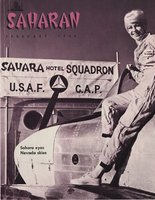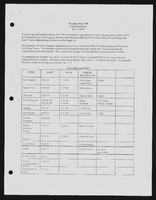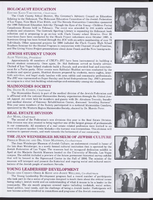Search the Special Collections and Archives Portal
Search Results

Transcript of interview with Perle Garrett by Marilyn Swanson, March 2, 1975
Date
Archival Collection
Description
On March 2, 1975, Marilyn Swanson interviewed her neighbor Perle Garrett (born April 27, 1905 in Overbrook, Kansas) in her home in Boulder City, Nevada. This interview covers Boulder City during the 1930s, with special focus on the building of Boulder Dam. Mrs. Garrett relocated to Boulder City because her husband Theodore Garrett was one of the workers at the dam. She also discusses Six Companies houses, family life, the weather, churches in Las Vegas and recreational activities for local children. Her husband is also present during the interview.
Text

Saharan Magazine from the Sahara Hotel and Casino, February 1966
Date
Archival Collection
Description
The February 1966 edition of The Saharan Magazine, a magazine created by the Sahara Hotel and Casino in Las Vegas, Nevada. Headlines in the magazine include: "Sahara Winder Lineup: Kinds and DeCastros", "Canadian Tops Winners in Sahara Anniversary", "Sahara Airlines Attendance Soars Over 6,000 Mark", "Sahara Becomes "Shooting Headquarters" in 1966", and "Thunderbird Cash Binge!"
Mixed Content

Sonny V. Mallari oral history interview: transcript
Date
Archival Collection
Description
Oral history interview with Sonny V. Mallari conducted by Chanele Mallari on November 26, 2021 for Reflections: The Las Vegas Asian American and Pacific Islander Oral History Project. Sonny Mallari talks about his childhood in Masantol, Pampanga province, Philippines with his five siblings. He discusses his family's immigration to Salinas, California and details of his life and parents' lives in the United States. Sonny shares stories of being bullied in school and what the immigration process was like from his point of view at the age of seven. He also talks about his professional work as a cook, moving to Las Vegas, Nevada for work, and becoming a Culinary Workers Union member.
Text

Alpha Kappa Alpha Sorority, Theta Theta Omega Chapter Founders Day committee reports
Date
Archival Collection
Description
From the Alpha Kappa Alpha Sorority, Incorporated, Theta Theta Omega Chapter Records (MS-01014) -- Chapter records file.
Text

Yazmin Beltran oral history interview: transcript
Date
Archival Collection
Description
Oral history interview with Yazmin Beltran conducted by Rodrigo Vazquez and Barbara Tabach on February 4, 2019 for the Latinx Voices of Southern Nevada Oral History Project. Beltran discusses her early life in Mexicali, Baja California, Mexico and her childhood and upbringing in Mexico. In 2003, at the age of eighteen, she and her mother joined the rest of her family in Las Vegas, Nevada. After attending College of Southern Nevada and taking English as a Second Language classes, Yazmin began to write as a Spanish contributor for a publication in Reno, and became a writer for Spanish publications in Las Vegas, including El Tiempo, El Mundo, and Univision. Beltran's work for Univision led her to Texas, where she covered events and crises including the 2018 child separation occurring at the United States border, which she discusses in the interview. Finally, Beltran talks about being a journalist for The Nevada Independent and the importance of continuing to report in Spanish.
Text

Transcript of interview with Pauleen Foutz by Don Scott Kaye, February 25, 1980
Date
Archival Collection
Description
Text

Brittany Castrejon oral history interview: transcript
Date
Archival Collection
Description
Oral history interview with Brittany Castrejon conducted by Claytee D. White and Barbara Tabach on November 9, 2017 for the Remembering 1 October Oral History Project. In this interview, Brittany Castrejon details her experiences during the evening of the 2017 mass shooting in Las Vegas, Nevada. She describes the Route 91 Harvest Festival set-up and details the events of that night, which she experienced alongside her 14-year-old cousin and a few friends. Castrejon tells her story of trying to find safety from the chaos during the entire ordeal, eventually finding refuge for the remainder of the night at the Tropicana hotel. She ends the interview by discussing her adjustment to life after the shooting and her post-traumatic stress disorder, as well as what she has learned from the experience.
Text
Alton Dean Jensen Architectural Records
Identifier
Abstract
The collection is comprised of architectural records (1943-2009) completed by American architect, Alton Dean Jensen and/or his architectural firm, Alton Dean Jensen Architect, AIA, and contains 263 sets of drawings and 95 sets of project records from over 200 different projects. Primarily focusing on the Nevada area and Utah area with some projects also located in Arizona, California, Wyoming, Colorado, South Dakota, Montana, and Idaho, the materials feature hand-drawn architectural drawings, ranging from preliminary sketches to construction documents, and project records, like structural calculations and project specifications. The drawings also contain work from consultants, engineers, and other architects who collaborated on the development of the various projects. The drawings include: commercial, industrial, professional, civic, residential, and religious buildings of varying scales, such as convenience stores, hotels, casinos, shopping centers, warehouses, office developments, schools, military buildings, churches, and custom single-family homes located throughout the Southwest (United States). The drawings also include a number of additions, remodels, and renovations. The drawings contain work from the Miles E. Miller Architecture firm, where Alton Dean Jensen first worked in Salt Lake City, Utah in the 1950s. The records include: structural calculations and drawings, project manuals and specifications, bid documents, and professional correspondence.
Archival Collection
Robert Woodruff Papers
Identifier
Abstract
The Robert Woodruff Papers (1927-2001) are comprised of materials documenting Woodruff’s career and family life in Las Vegas and Henderson, Nevada, as well as his travels around the United States and abroad. Materials include newspaper clippings, photographic prints and transparencies, personal correspondence, and publications such as Las Vegas tourist brochures and pamphlets dating from the 1930s and 1940s. Visual materials include portraits, city scenes, and landscapes throughout Nevada and the United States, as well as some photographs of international travels.
Archival Collection

